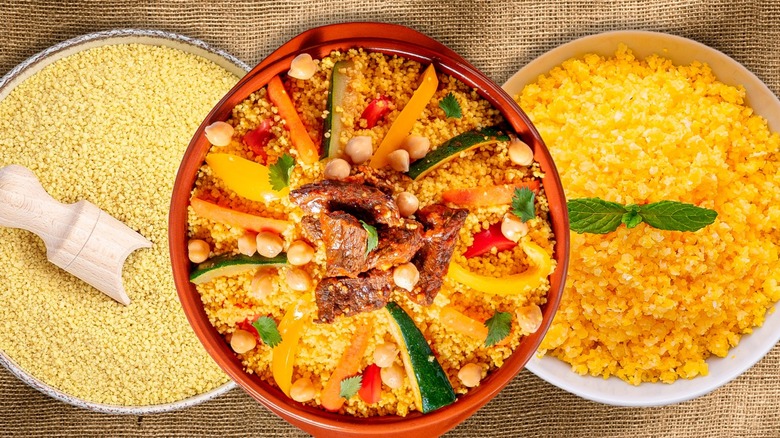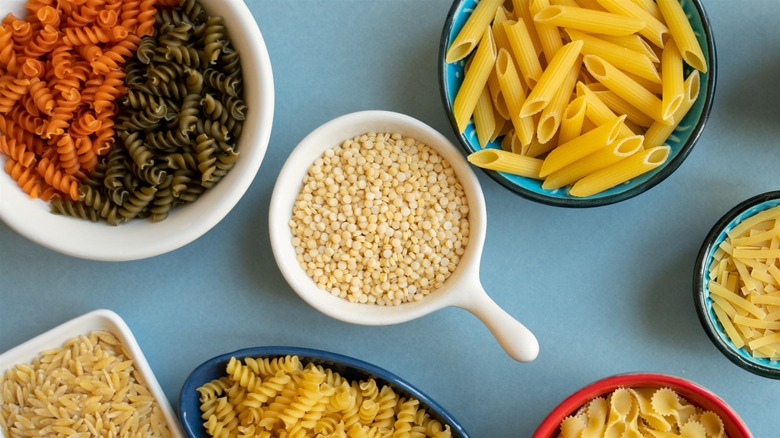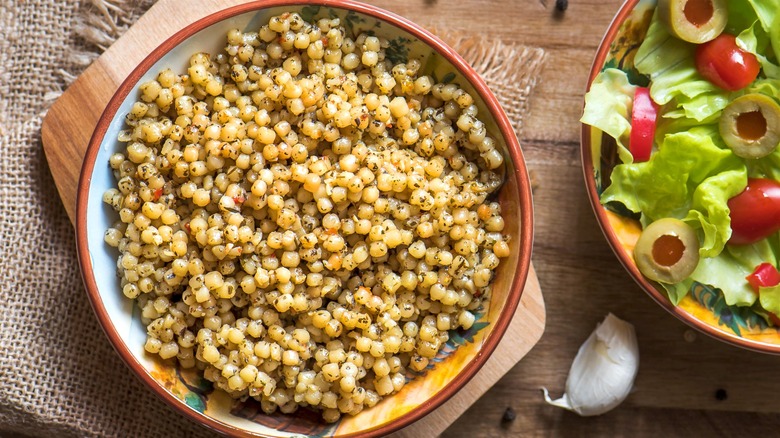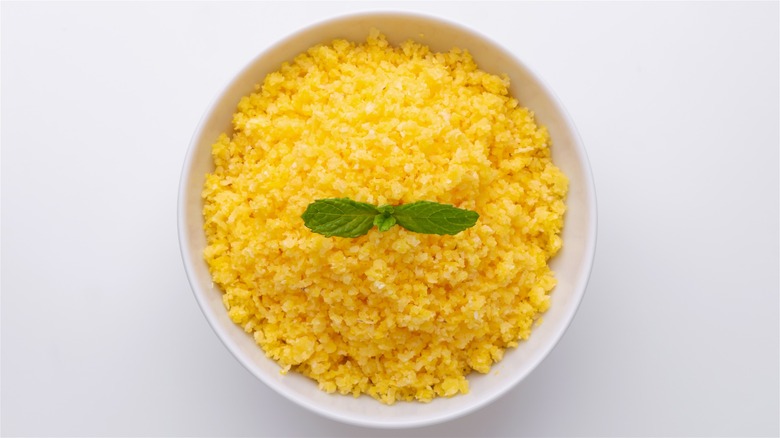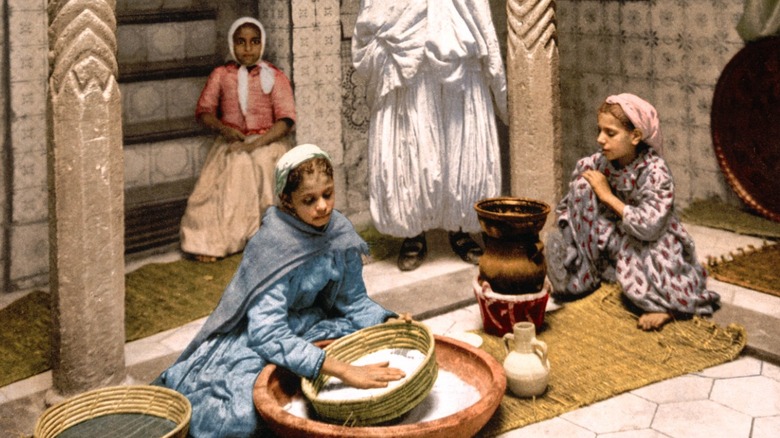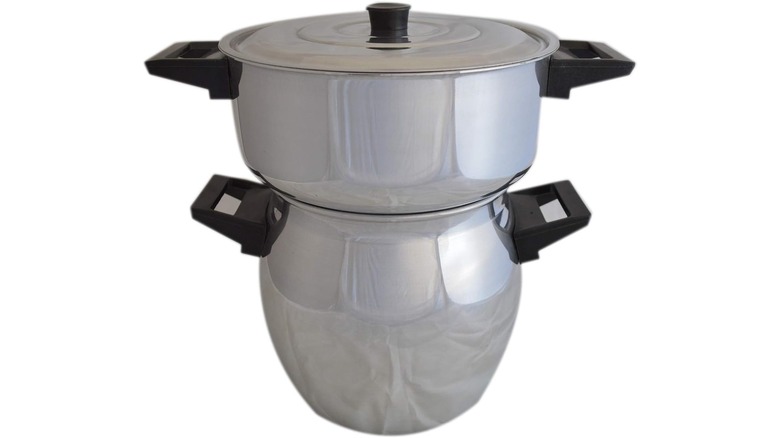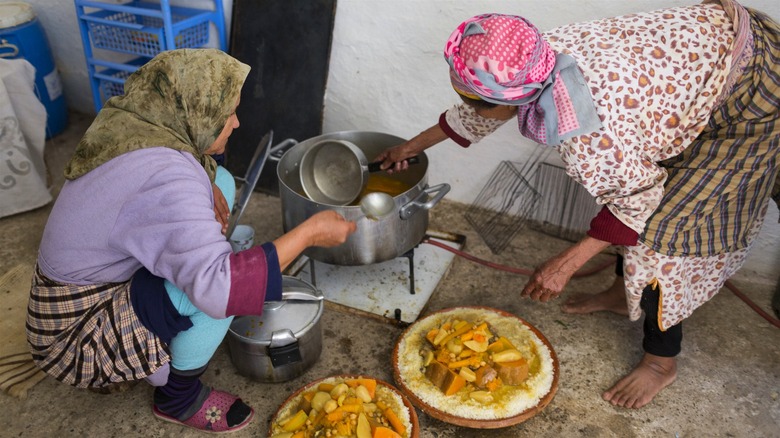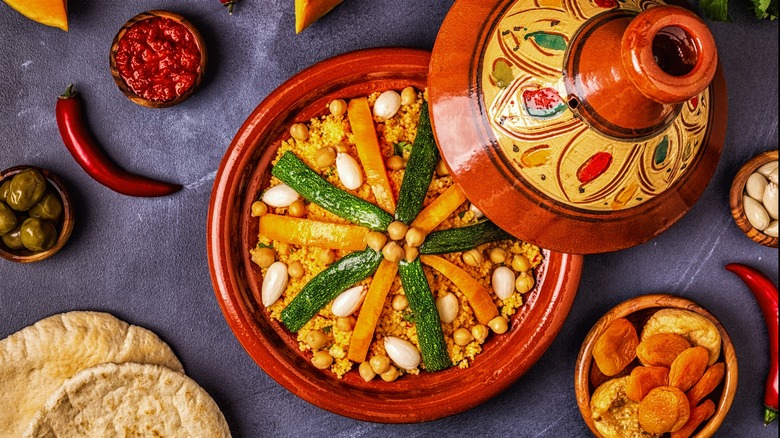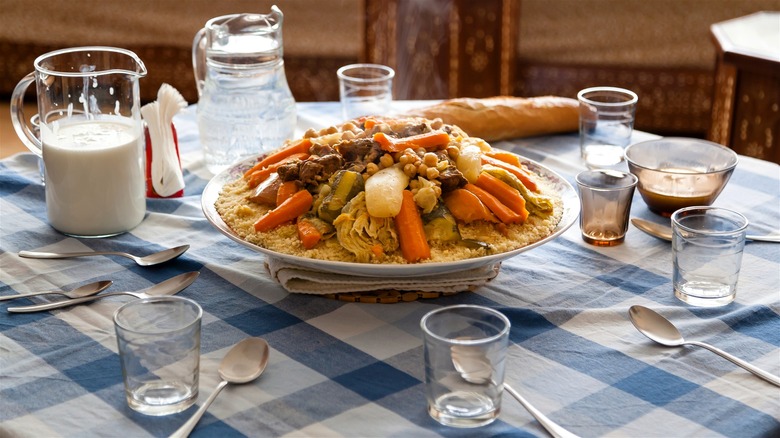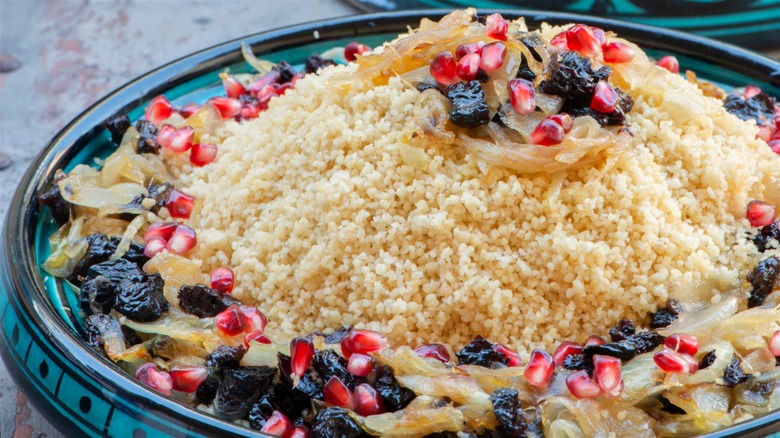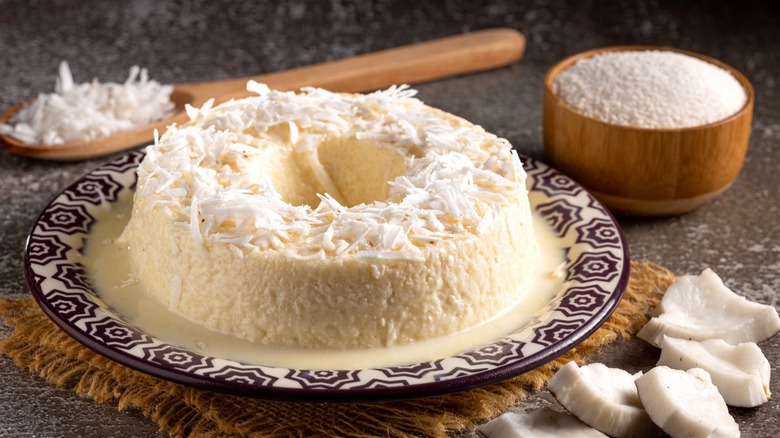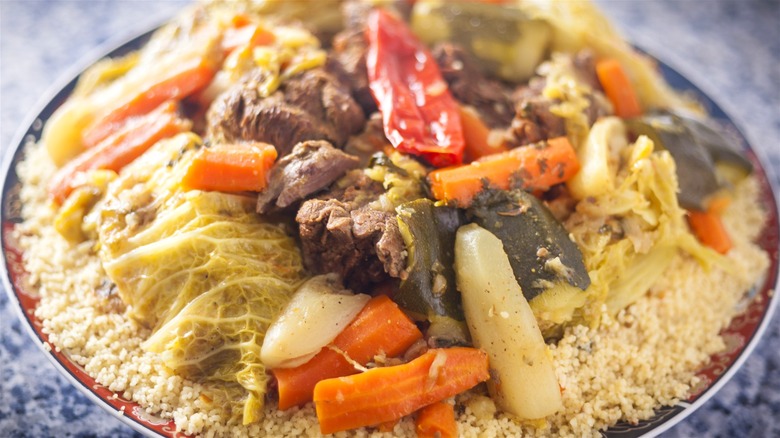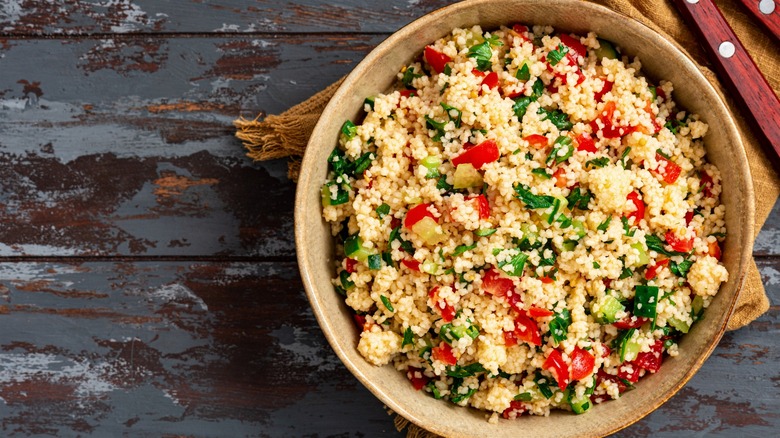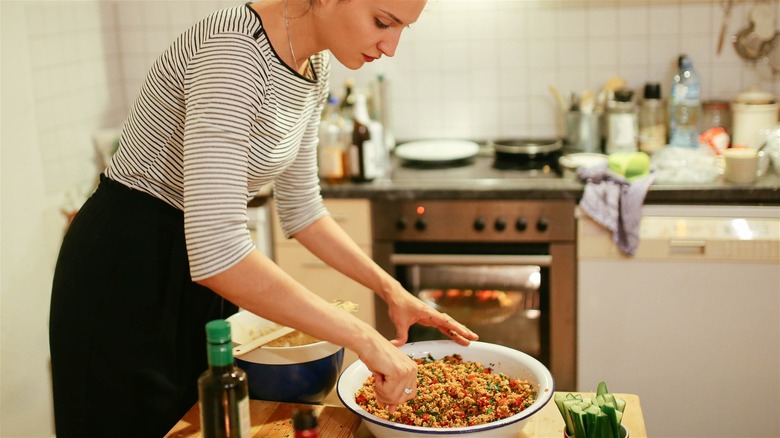13 Facts You Need To Know About Couscous
We may receive a commission on purchases made from links.
At first glance, couscous seems like a simple, maybe even unexciting, side dish. But scratch its surface, and you'll find layers of historical and cultural significance and a cornucopia of couscous recipes. Descended from the ancient Berber tribes of Northern Africa, couscous traveled the world by means of colonization, immigration, and slave trade, reimagined in every place it arrived to, from Brazil to France. This humble grain (which, in reality, isn't a grain at all) is mostly seen by Westerners through the lens of nutritious salads and is revered for its ease of preparation. However, traditional couscous making is no small feat.
In its native Maghreb, which spans several countries like Algeria, Morocco, and Tunisia, couscous is a dish of utmost importance. To this day, it is often prepared by the hands of women from start to finish, resulting in rich dishes whole communities can gather around. The repeated steaming and fluffing required for authentic couscous gave rise to special equipment, which introduced Europeans to steaming as a cooking technique, then fell out of fashion as industrialized instant couscous took over the market. So, the next time the craving strikes, you'll be armed with these delicious facts, which will help you cook it perfectly while paying respect to its origins.
Couscous is technically a pasta, not a grain
To understand the versatile nature of couscous, we must first ask ourselves: Is it a grain or a pasta? In short, it straddles both categories without fitting perfectly in either. Couscous certainly looks like a grain, cooks like a grain, and is often served like a grain, but its ingredient list tells us it has more in common with pastina than it does with quinoa. Like pasta, couscous is made from ground durum wheat, which is sprayed with water and tossed until small granules form.
Thus, one of the most common couscous mistakes you can make after learning of its pasta lineage is cooking it like one. Using copious amounts of boiling water might fly with pearl couscous, which has larger, pasta-sized morsels ideal for this cooking method. But for the common Moroccan couscous, boiling is a mushy, sticky death sentence. That's why cooking raw couscous the traditional way takes several steams and relentless fluffing. Fortunately, the stuff you'll find on supermarket shelves is most likely to be pre-steamed, meaning all you need to do is rehydrate it in hot water on the counter for a few minutes, then fluff it by hand or with a fork, and you're ready to go.
There are three main varieties of couscous
Unless you're an avid couscous consumer, the image this word conjures is likely that of a small, fluffy, quick-cooking golden grain. But if you dare to dig deeper, there is more to couscous than you're probably used to. While in some countries, it's made from a variety of grains, the three most commonly available types of couscous are semolina-based Moroccan, Israeli, and Lebanese. The key difference between the three is evident at first glance: Moroccan is made up of very fine granules, whereas Israeli (also known as pearl couscous) is slightly larger, similar to the size of peppercorns or small pasta. Lebanese couscous is the largest of the three, its morsels closer to the size and color of peas.
This difference in size brings about distinct flavors, textures, and cooking methods. While you'd normally use a 1-to-1 ratio of grain to water to reconstitute Moroccan couscous off the heat, Israeli and Lebanese call for a 1.5-to-1 and 3-to-1 ratio, respectively. You should cook them like pasta, for 10-15 minutes on the stovetop. The nutty, mildly sweet flavor of Moroccan couscous is intensified in larger varieties, as is the chewiness. All three make an excellent salad base, but larger varieties will shine in soups and stews, as well.
It can be made from different grains
The North African couscous we know and love is, unfortunately, not gluten-free, as the pseudograin is made from wheat. But this wasn't always the case. The Berbers, who are credited with the invention of couscous, initially built it with what was available at the time. Before the 11th or 12th centuries, when wheat farming became more commonplace, these Maghreb natives likely made couscous from acorn flour and barley. Since then, its ingredient list and cooking methods haven't changed much. However, in some places around the world, other grains are still given the couscous treatment.
Barley couscous is still enjoyed in Morocco and the Atlas Mountains stretching across the region. Algeria boasts a unique twist on it called m'ziyet, or black couscous, for which barley is fermented underground for years. Brazil and other South American countries had to adapt their couscous dishes to local grains, namely, corn meal, which is steamed in a similar manner to Moroccan couscous. Though rarely found in stores, Senegalese sorghum and millet flour-based couscous blanc, as well as Bulgarian breznitsa couscous made from corn flour, are still prepared in the homes by those willing to preserve local culinary traditions.
Couscous production was traditionally reserved for women
One deep look at couscous' history is enough to see that it's a true labor of love, and the Maghrebi women are the unsung heroes behind its creation. Since 200 BCE, they have been passing down the tradition of hand-rolling couscous, a process that sometimes kicks off months before the communal dish hits the table. Their technique is as intricate and meticulous as it is backbreaking: they spend hours rubbing semolina to form those tiny, irregular granules, then deftly sift, roll, and sort them until every grain is just right. Each part of the process is a ritual in and of itself, often accompanied by song.
Cooking the grains for the whole family or extended community also fell on women's shoulders, and it became their enduring legacy outside of Africa. It wasn't until the 1970s, when French laws allowed North African immigrants to bring their families over, that couscous started to gain traction across the pond. But it's not all tradition and nostalgia; women are carving out new paths for themselves with this ancient craft, running all-female organizations such as Algerian Maison Lahlou, or Moroccan Aboghlo Women's Cooperative. Such initiatives not only preserve a revered culinary tradition, otherwise neglected due to industrialization and lack of interest from younger generations but also help women find empowerment and financial security.
Couscous has its own cooking vessel
Not many dishes boast a long and storied history intertwined with a unique cooking device, but couscous is one of them. Although its evolution into the modern-day quick-cooking grain made these special pots nearly obsolete in home kitchens, they're still used to make couscous the traditional way. Couscoussier, as it's been known since the 1920s, has two essential parts: a voluminous base pot known as gdra or barma, used to stew meats and vegetables, and an eponymous wide steamer basket, keskes. Additionally, a kaffal — an extra layer of damp fabric — can be used between the two to prevent steam from escaping, turning the couscous pot into a water-saving device operating on dry steam. Lids completed the set only in the 20th century.
Once, Maghrebi women cooked their couscous in copper or, in rural areas, terracotta pots. The latter were hand-made by female potters not for profit but for personal and communal use. However, with the advent of aluminum in the 1920s, the couscoussier got a European makeover, becoming a modern kitchen tool and introducing the French to the art of steaming. Though its use has dwindled, the couscous pot remains a poignant symbol in the Maghrebi diaspora, preserving cultural traditions and sensory memories for those who cherish its significance.
Traditional couscous cooking method is quite laborious
Far from the convenience of instant couscous widely available outside of North Africa, the traditional method, using the special couscoussier takes lots of vigilant effort. As the bottom pot stews meats and vegetables that will later be slathered over the fluffy mound, Maghrebi women prepare the couscous for the top one. They place the raw grains on a large plate and moisten them with salted water and olive oil, gently massaging them between their hands to ensure even coating. The first steam takes 20-25 minutes, after which the grains are returned to the large plate and, still hot, de-clumped by hand with the help of more water and oil. They repeat this process twice more, reducing the steaming sessions to around 15 minutes.
The pot's design allows for the creation of dry steam, which cooks couscous efficiently, gently gelatinizing its starches without turning it mushy, and, as an added bonus, it infuses the grains with the aroma of the stew below. While we can all appreciate the five-minute side dish, it reportedly does not yield the same fluffy texture or the mouthfeel of couscous that's been repeatedly steamed and fluffed by hand. So, if you can get your hands on a couscoussier (or substitute with an ordinary cheesecloth-laced steamer), try it for yourself and feel the difference.
Couscous is not the same as tagine
What do you see when you picture "traditional" or "Moroccan" couscous? Is it an inviting, vibrant, steaming-hot dish of meats and vegetables layered over a mound of steamed grains that are revealed once its conical terracotta lid is lifted? If so, you might be confusing it with tagine. The term itself means both the earthenware pan with a dome-shaped lid and the dish that's cooked in it. Thus, you make couscous in a couscoussier, and you make tagine... in a tagine. Both pots were designed to get the most out of a limited water supply, steaming the food inside, but they serve different culinary purposes. The tagine pan is also used to serve food, whereas a couscoussier is confined to the kitchen.
The differences between couscous and tagine go beyond cookware, however. While the former makes a complete meal, layering a rich stew over steamed grain, the latter layers vegetables over meat, skipping the starchy side. To make up for it, tagine is traditionally served with round flatbread known as khobz, sans utensils. Of course, there's no rule saying you can't switch things up, but the result won't be strictly authentic, and learning the difference between the two shows respect to the cultures that brought us these unique dishes.
It's a TGIF dish in Morocco
Couscous is not only one of the essential ingredients of Moroccan cooking, it's a defining dish of the country's culinary tradition. Not unlike the Christian custom of after-church Sunday dinners, in Morocco, Fridays are for couscous. The whole country hits pause for this meal — big families, small villages, bustling cities — everyone's in on it. On this day of prayer, women cook couscous in large quantities and later serve it to their extended family members in communal bowls. For those who don't cook, there's always a local café dishing out steaming bowls of couscous. Some joints are so into it they don't bother serving anything else on Fridays.
Moroccan couscous can be served with utensils, but traditionally, it's eaten without them. So, should you ever find yourself at a Moroccan communal table, you'll need to remember the ground rules of eating with your hands. First, you should only use your right hand (needless to say, it should be clean). Second, you're not supposed to lick your fingers — that's essentially double-dipping. It might take some practice, but you should eventually be able to form couscous into bite-sized balls with ease. Finally, you should stick to the side of the communal dish facing you instead of reaching for far corners.
Couscous can be served sweet or savory – or both
Many of us are used to couscous served as a part of Mediterranean-inspired salads, or served Moroccan style, with a vegetable and meat stew. Pairing it with herbs, spices, and vegetables seems natural to a Western palate, but in its native region, couscous bridges the gap between sweet and savory. For instance, a variation of a Maghrebi dish known as seffa mixes braised meat with sweetened couscous. Raisins are a common couscous addition in Algeria, and during Ramadan, they take center stage in mesfouf b'zbib, a simple raisin-studded steamed couscous dish that can be served sweet or savory. Dates and nuts are added to the sweet version. In Morocco, they love to serve couscous with tfaya, a sweet topping of caramelized onions, raisins, and warming spices.
Egyptians, on the other hand, have turned the versatile grain into a full-on dessert, served with sugar, almonds, walnuts, coconut flakes, and sometimes honey or sweetened condensed milk. So, if you want to take a leaf out of their book, try to swap oats for couscous for your morning cereal. Rehydrating it in cinnamon-laced plant-based milk and topping it with fresh or frozen berries, chopped nuts, dried fruit, and a splash of syrup will make a delectable breakfast.
Brazil has a unique take on couscous
After being introduced in the 16th century through Portuguese colonizers and the Transatlantic slave trade, couscous became a prominent part of Brazilian cuisine. But if craving ever strikes you in São Paulo, prepare to be surprised. For one, cuscuz paulista is made from flaked cornmeal. It also resembles a savory cake, as it's first left to set in a dome-shaped mold, topped with hard-boiled eggs, sardines, and shrimp. In the northeast of the country, it got yet another makeover: Cuscuz nordestino is a breakfast staple in the shape of a steamed cornmeal cake. This vegetarian-friendly Brazilian dish is served hot, topped with butter, and sometimes milk, vegetables, or meats.
And if you thought the Egyptian custom of mixing couscous with powdered sugar and dried fruits was something out of the ordinary, then another Brazilian spin on the dish might just knock it out of the park. Introducing: tapioca couscous. Commonly found in Rio de Janeiro, it abandons the traditional couscous image entirely, presenting itself as a sweet pudding made from tapioca pearls, freshly grated coconut, sugar, and different types of milk (coconut, condensed, and whole all make an appearance). It does share one thing with Maghrebi couscous, though: It's believed to be invented and traditionally prepared by women.
It's been recognized as intangible cultural heritage
What does couscous have in common with Ukrainian borscht, French baguette, and Korean kimchi? All of the above are on UNESCO's Intangible Cultural Heritage list, which celebrates the cultural significance and traditional practices surrounding a specific dish. Typically, it's not just about the food itself, but the entire ritual and social customs linked to its preparation and consumption. It's like saying, Hey, world, this dish isn't just about flavors — it's about history, community, and artisanal skills. And it deserves to be celebrated and protected.
But unlike these single-origin examples, couscous' appearance on the list was a joint effort of four Maghreb countries: Algeria, Mauritania, Morocco, and Tunisia. Couscous has many variations across the region: Algerian and Mauritanian couscous is hearty and modestly spiced, the Tunisian variety rocks a red-hot hue from harissa and tomato paste, whereas Moroccan couscous packs a flavor punch from a generous addition of spices. Despite the political tensions and a certain degree of animosity between these countries, who all claim to own the dish, this cross-Maghreb expression of a shared culinary identity and a deep love for the dish might just reawaken the feeling of unity. After all, couscous has always been deeply imbibed with a sense of community, from production to plate.
Couscous is chock-full of selenium
Couscous isn't just a carb-fueled dish with a rich history — it's packing health perks, too. Its key attraction for health-conscious eaters is selenium, the Swiss Army knife of antioxidants. Whether it's damaged cells, inflammation, or oxidative stress, selenium can take care of it. This mighty little nutrient is also capable of keeping your thyroid health in check and giving your hormone production a leg up. As an antioxidant, it can support heart health, preventing the accumulation of unhealthy LDL cholesterol in your blood vessels. And if you eat a mere cup of couscous, you'll be getting 43.2 micrograms of selenium, which is 78% of the recommended daily intake.
But the perks don't stop there. While its protein content, at 6 grams per cup, is modest compared to other foods, it's still a welcome boost for plant-based eaters. Plus, when it's tossed into a salad with beans or chickpeas, it turns into a protein-packed meal. Finally, with its high carb content, couscous is a key player in keeping your metabolism, growth, and energy levels in top form. So, while couscous may look like just another grain on your plate, it's secretly working overtime to keep your body in top shape.
It might be hard to get right on the first try
For a dish so deceptively simple, couscous is notoriously finicky. Even if you don't rush out to buy a couscoussier and attempt to prepare it the Moroccan way, there are still plenty of mistakes you can make. But don't fret: once you master the basics, you won't ever have to deal with mushy, burnt, or bland couscous ever again.
The first thing you need to remember is that different couscous types cook differently. Instant couscous needs to be rehydrated off the stove, in a 1:1 liquid-to-grain ratio. Raw Moroccan couscous needs to be steamed repeatedly in a couscoussier or a DYI alternative. In turn, Israeli and Lebanese varieties cook longer and require more water, like pasta. Regardless of the type you use, apply one crucial couscous seasoning tip: Salt the water first. Or, better yet, use a flavorful broth to cook the grains in. Once it's done, it is essential you let couscous rest. A well-rested couscous is a tender and flavorful couscous. And finally, you'll need to avoid the fluffing mistake of giving it a couple of prods with a fork and calling it a day. Use lightly oiled hands to rub and break apart grain clusters once they're cooked, and never look back.
